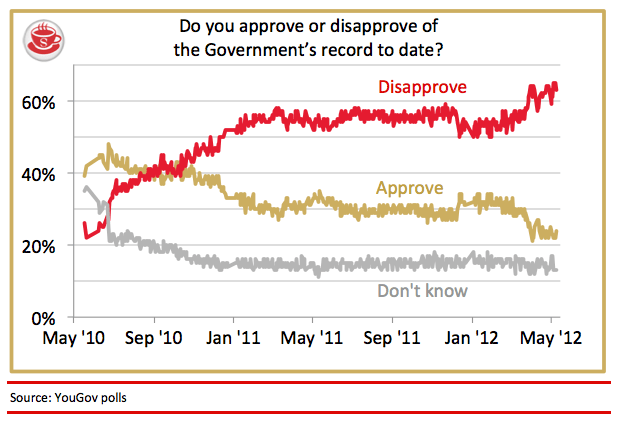As the coalition celebrates its second birthday, it seems as good a time as any to take a look at how it’s doing in the eyes of the public. First, here’s how the government’s
approval rating — as measured by YouGov — has changed
since its formation:
As you can see, the coalition took office with reasonably good ratings, but the first ten months or so — which included the Comprehensive Spending Review and the tuition fees vote — saw
public opinion turn against it. For the rest of 2011, the ratings stayed fairly flat, with the government neither regaining ground with the public nor losing any more — and there was even a
slight bump in popularity in early December, following David Cameron’s EU ‘veto’. But then came 2012 — with stories of a double-dip, granny tax, pasty tax and charity tax
— and the coalition’s unpopularity deepened even further.
And what has this meant for the two parties involved? Well, at the 2010 election, the Tories won 36 per cent of the vote, beating Labour by seven points. Now, the polls have them at around 31 per
cent — 13 points adrift of the red team. In fact, in this week’s YouGov polls, Cameron’s party is on just 65 per cent
among 2010 Conservative voters. In other words, just two out of every three people who voted Tory in 2010 say they’d do so again if there were an election tomorrow. Nine per cent of them say
they’d vote UKIP, seven per cent would go to Labour, 13 per cent don’t know and 4 per cent say they wouldn’t vote at all.

Compare that with Labour, who are currently retaining about 82 per cent of their 2010 voters. So four out of every five people who voted Labour last time are sticking with them.

And, on top of that, Labour has picked up around 30 per cent of the Liberal Democrats’ 2010 voters. Clegg’s party has dropped from the 23 per cent share they received at the general
election to around ten per cent now, and YouGov show that fewer than one-in-four of their 2010 voters still back the party.

As this chart shows, a large number of 2010 Lib Dem voters are still up for grabs. 38 per cent of them are currently undecided, say they wouldn’t vote or would vote for one of the smaller
parties. The Lib Dems’ hope is that they can persuade these voters to come back to them in time for the next general election.






Comments